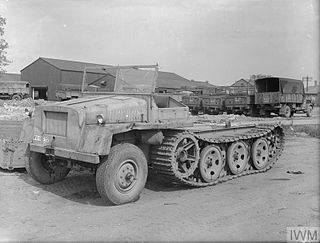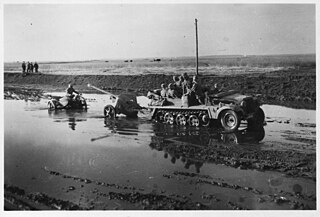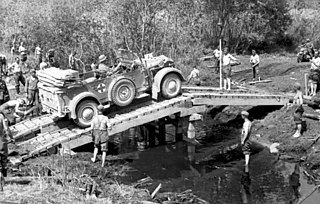
The Leichter Panzerspähwagen was a series of light four-wheel drive armoured cars produced by Nazi Germany from 1935 to 1944.

A half-track is a civilian or military vehicle with regular wheels at the front for steering and continuous tracks at the back to propel the vehicle and carry most of the load. The purpose of this combination is to produce a vehicle with the cross-country capabilities of a tank and the handling of a wheeled vehicle.

The Sd.Kfz. 251 half-track was a World War II German armored personnel carrier designed by the Hanomag company, based on its earlier, unarmored Sd.Kfz. 11 vehicle. The Sd.Kfz. 251 was designed to transport the Panzergrenadier into battle. Sd.Kfz. 251s were the most widely produced German half-tracks of the war, with at least 15,252 vehicles and variants produced by seven manufacturers. The utility of this vehicle lead the German Army to develop the similar looking but shorter and lighter Sd.Kfz. 250 as a supplement.

The Schwerer Panzerspähwagen, is a series of six- and eight-wheeled armoured cars that were used by Germany during the Second World War.

The Sd.Kfz. 250 was a light armoured half-track, very similar in appearance to the larger Hanomag-designed Sd.Kfz. 251, and built by the DEMAG firm, for use by Nazi Germany in World War II. Most variants were open-topped and had a single access door in the rear.

The Sd.Kfz. 6 was a half-track military vehicle used by the German Wehrmacht during the Second World War. It was designed to be used as the main towing vehicle for the 10.5 cm leFH 18 howitzer.

The Sd.Kfz. 7 was a half-track military vehicle used by the German Army, Luftwaffe and Waffen-SS during the Second World War. Sd.Kfz. is an abbreviation of the German word Sonderkraftfahrzeug, "special purpose vehicle". A longer designation is mittlerer Zugkraftwagen 8t, Sd.Kfz. 7, "medium towing motor vehicle 8t".

The Goliath tracked mine was a series of two unmanned ground vehicles used by the German Army as disposable demolition vehicles during World War II. These were the electrically powered Sd.Kfz. 302 and the petrol-engine powered Sd.Kfz. 303a and 303b. They were known as "beetle tanks" by the Allies.

The Schwerer Wehrmachtschlepper was a German World War II half-track vehicle used in various roles between 1943 and 1945. The unarmored models were used as supply vehicles and as tractors to haul artillery. Armored versions mounted anti-aircraft guns or a 10 barrel rocket launcher (Nebelwerfer). Fewer than a thousand were built before the end of the war, but production continued after the war of an improved model in the Tatra plant in Czechoslovakia.

Sd.Kfz. 253 leichter Gepanzerter Beobachtungskraftwagen was a German half-track observation vehicle that was used by artillery forward observers to accompany tank and mechanized infantry units. The vehicle belonged to the Sd.Kfz. 250 family. The appearance was similar to the Sd.Kfz. 250, but the Sd.Kfz. 253 variant was fully enclosed. Demag/Wegman manufactured 285 vehicles between 1940–1941.

The Sd.Kfz. 10 was a German half-track that saw widespread use in World War II. Its main role was as a prime mover for small towed guns, such as the 2 cm Flak 30, the 7.5 cm leIG, or the 3.7 cm Pak 36 anti-tank gun. It could carry eight troops in addition to towing a gun or trailer.

The Sd.Kfz. 11 was a German half-track that saw widespread use in World War II. Its main role was as a prime mover for medium towed guns ranging from the 3.7 cm FlaK 43 anti-aircraft gun up to the 10.5 cm leFH 18 field howitzer. It could carry eight troops in addition to towing a gun or trailer.

The Sonderkraftfahrzeug 8, usually abbreviated to Sd.Kfz. 8, was a German half-track designed by Daimler-Benz that saw widespread use in World War II. Its main roles were as a prime mover for heavy towed guns such as the 21 cm Mörser 18, the 17 cm Kanone 18 and the 10.5 cm FlaK 38, however it was also capable of serving as an infantry transport. Approximately 4,000 were produced between 1938 and 1945. It was used in every campaign fought by the Germans in World War II, notably the Invasion of Poland, the Battle of France, the Balkans Campaign, the Eastern Front, the North African Campaign, the Battle of Normandy and the Italian Campaign.

Einheits-Pkw der Wehrmacht – literally: "standard passenger motor-car of the Wehrmacht" – was the Nazi German plan for a new, multi-purpose fleet of all wheel drive off-road vehicles, based on just three uniform chassis, specifically designed and built for the Wehrmacht. The plan was formulated in 1934, and vehicles were built from 1936 to 1943.
The 8.8 cm Flak 18 (Sfl.) auf Zugkraftwagen 12t , also known as the Bunkerflak or Bufla, was a German Wehrmacht half-track self-propelled gun developed before World War II and used in the first half of the war. It was used during the Invasion of Poland but is best known for its use during the Battle of France, where it was the only German self-propelled gun capable of destroying the heavier Allied tanks such as the French Char B1 and the British Matilda II. Remaining vehicles were used on the Eastern Front. The last Bufla was destroyed in 1943.



















